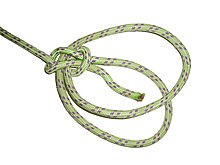Knots
Several types of knots can be distinguished for a variety of purposes. Although in many cases any knot can be used for any specific purpose, these specialised knots have been invented to be able to perform any specific job in the most efficient way (e.g. facilitating untying after a job has been done).
Contents[edit | edit source]
Introductory material[edit | edit source]
Basic knots[edit | edit source]
This is a simplified list of knots which keeps a balance between usage for many purposes, reasonably good performance (e.g. easy untying, difficulty of laying the knot) and a fair amount of simplification (to avoid needing to learn a great number of them). These basic knots will still allow you to help yourself out in survival situations and in low-tech construction (e.g. in the developing world).

- Bowline for making a loop
- Constrictor for tying a rope to something solidly
- Diagonal lashing and round lashing for holding pieces of structures together in low-tech construction
- Figure-eight knot for making a part of a rope too big to fit back through a hole
- Lark's head for vertically (gravitational tensing) hanging, or horizontally (if tension is assured) link a rope to another or to an object if slippage can be avoided by that object structure, position and or stability.
- Reef knot a specialization of the Lark's head for tying two lines or the ends of a single line together such that they will secure something that is unlikely to move much, initial tension will make it more reliable than the simpler Lark's head if constant tension is not guaranteed.
- Sheet bend and double sheet bend for tying two ropes together in general situations
- Two half-hitches for quickly tying a rope to something
More knots[edit | edit source]

The list of knots is extensive, but common properties allow for a useful system of categorization. For all the knots, see Category:Book:Knots.
- Bend knots
- A knot uniting two lines (for knots joining two ends of the same line, see Binding knots or Loop knots (list of bends).
- Binding knots
- A knot that restricts object(s) by making multiple winds (list of binding knots).
- Coil knots
- Knots used to tie up lines for storage (coil knots).
- Decorative knots
- A complex knot exhibiting repeating patterns often constructed around and enhancing an object (list of decorative knots).
- Heaving knots
- Knots that make a line easier to throw.
- Hitch knots
- A knot tied to a post, cable, ring, or spar (list of hitch knots).
- Lashing
- A knot used to hold (usually) poles together (lashing).
- Loop knots
- A knot used to create a closed circle in a line (list of loop knots).
- Slip knots (or Running)
- A knot tied with a hitch around one of its parts, contrasted. with a loop, which is closed with a bend. A slip knot can be closed, a loop remains the same size (slip knots).
- Seizing knots
- A knot used to hold two lines or two parts of the same line together (seizing).
- Sinnet knots
- A number of lines interwoven in a pattern (sinnets)

Some monkey fists - Rope splicing
- A method of interweaving strands of rope to join sections together. More time consuming but usually stronger than simple knots (list of splices).
- Stopper knots
- A knot tied to hold a line through a hole (stoppers).
- Trick knots
- A knot that is used as part of a magic trick, a joke, or a puzzle (trick knots).
- Whipping
- A binding knot used to prevent another line from fraying.
Additional reading[edit | edit source]

- Klutz book of knots
- Ashley, Clifford W. The Ashley Book of Knots. Doubleday, Doran & Co. New York, 1944, and Faber & Faber, London, 1947 & 1993 (revised ed.).
- Budworth, Geoffrey. Guide to Knots. Parragon Publishing, Bath, 2005.
- Hopkins, Richard. Knots. Salamander Books, Great Britain, 2003.
- Pawson, Des. Knots & Splices. PRC Publishing, Great Britain, 2001.
- Perry, Gordon. Knots. Grange Books, Great Britain, 2002.
- Warner, Charles. A Fresh Approach to Knotting and Ropework. NSW, Australia, 1992.
